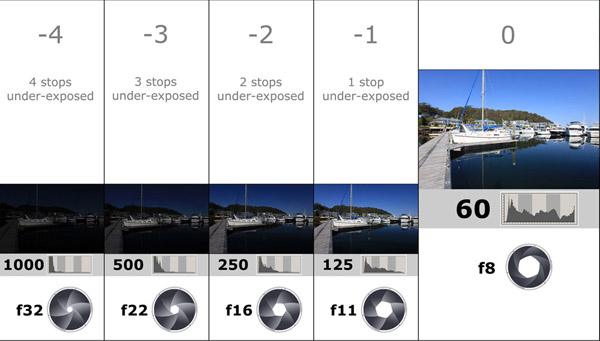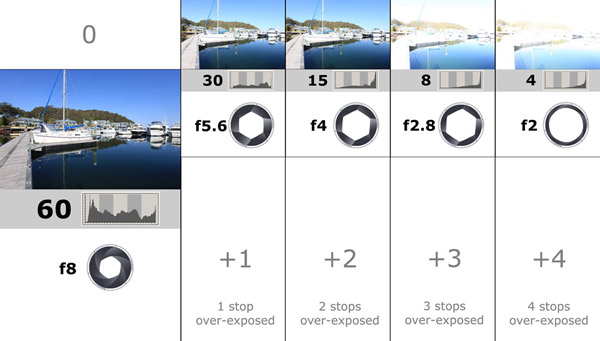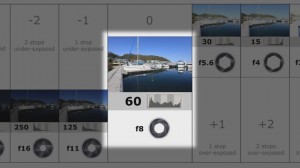What is Exposure in Digital SLR Photography?
Firstly lets look at exposure in its simplest form.
Exposure is basically the brightness of your image.
Another way of looking at exposure is to think of it as the amount of light recorded by your digital sensor.
Under-Exposing the Marina:
Below is a diagram that shows what happens when we shoot the exact same scene, but half the time that the sensor is exposed to light (going to the left).
The numbers correspond to Shutter Speed. The number 1000 is 1000th of a second that the shutter is open for, this is called the shutter speed. The large image on the right is properly exposed at 1/60th of a second. That means the shutter was open for 1/60th of a second to let light onto the sensor.

The diagram above shows how we can under-expose and image. Each image is 1 f-stop difference for the corresponding image, or double the light (going to the right), or half the light (going to the left) from the previous image. The large image is properly exposed at 1/60th of a second shutter speed.
“Have a look at my Exposure Video where I explain how exposure works and we test how aperture and shutter speed effects exposure in a studio portrait photo shoot.”
Over-Exposing the Marina:
Below is a diagram that shows what happens when we shoot the exact same scene, but double the time that the sensor is exposed to the light (going to the right).
The numbers correspond to shutter speed. The number 1000 is 1000th of a second that the shutter is open for, this is called the shutter speed.
The large image on the right is properly exposed at 1/60th of a second. That means the shutter was open for 1/60th of a second to let light onto the sensor.

The diagram above shows how we can over-expose and image. Each image is 1 f-stop difference for the corresponding image, or double the light (going to the right), or half the light (going to the left) from the previous image. The large image is properly exposed at 1/60th of a second
“You may need to go over this chart a few times and let it all sink in. This is the most difficult concept to understand, but once you get it, everything else will fall into place. Check out my exposure video for another look at exposure.”
Lets look at black and white image.
Remember the old days of film? What would happen if we were to print a roll of black & white film that was not exposed to light, and then exposed to light for too long?

Example of what black & white print would look like. From left to right, under-exposed, properly exposed, and the over-exposed to light.
A totally black image has had no exposure to light (under-exposed), and when you print that image it will be black, and there will be no detail at all.
On the other side of the scale, a totally white image has been exposed to light for too long (over-exposed) and will also have no detail in the final print.
A properly exposed image will have detail in the lightest (highlights) part of the print as well as in the shadows. Below is a properly exposed image with details in the highlights (boats and sky) as well as details in the shadows (water and trees).
Have a look at this free video on exposure. (it’s an mini version of the full exposure video)
F-Stops, what are they?
The best way to explain this is by using examples.

This image is 1 f-stop under-exposed, notice the shutter speed is double that of 1/60th second. At 1/125th of a second will let in half the light, the shutter is only open for half the time. Because this image is under-exposed we start to lose details in the darkest (shadows) part of the print.

This image is 1 f-stop over-exposed, notice the shutter speed is half that of 1/60th second, at 1/30th second. This will let double the light into the camera. Because this image is over-exposed, notice we start to lose details in the brightest (highlights) parts of the image.
1 F-stop is either half the light, or double the light.
Most digital SLR cameras allow us to adjust exposure by 1/3 of an f-stop increments. That means we have more control of exposure. So – 3 clicks in exposure change on your camera will result in 1 full f-stop change.
“ Don’t forget to have a look at my Exposure Video where I explain how exposure works and we test how aperture and shutter speed effects exposure in a studio portrait photo shoot.”
Don’t forget to have a look at my Exposure Video where I explain how exposure works and we test how aperture and shutter speed effects exposure in a studio portrait photo shoot.”


very good illustrations. I seem to be a visual learner so this format is great stuff. thanks Brent.
Thanks Dennis. Enjoy the rest of the course. Brent
how to choose a lens for the camera, I should consider, and I recommend light filters
Hi,
Let’s say that I want to take a picture of a bright star or Venus. Since it’s night, I must overexpose to catch all the possible light since the background is dark, is that correct?
Another thing, I noticed that when I want to overexpose, since I have shaky hands, I must lay the camera somewhere, or use a tripod. Why is that?
Hi Michael.
When shooting stars or planets, it is a totally new realm, because you will need a very long telephoto lens and because it’s really dark, will need long shutter speeds. Long shutter speeds means you need a tripod, but here is the issue. The earth is turning, so when you fix your camera on a tripod, and use too long a shutter speed (more than 30 seconds) you will start to get star trails. Have a look at my blog where I shoot the old dairy in Anna Bay, see the star trails?
Hi Brent,
The first two diagrams note a halving or doubling of the shutter speed and an opening or closing of the aperture 1 full stop. Surely this would result in a combined difference of 2 stops or am i missing something?
terry
Hi Terry, you are correct. Those first 2 diagrams are meant only to demonstrate 1 f-stop difference, when only changing shutter speed OR exposure, but not both at the same time.
-so-
If we change shutter speed (aperture is constant), the image will get progressively lighter -going right, and darker – going left.
If we change aperture (shutter speed constant), the image will get progressively lighter -going right, and darker – going left.
I will update this post soon to make it clearer. Brent